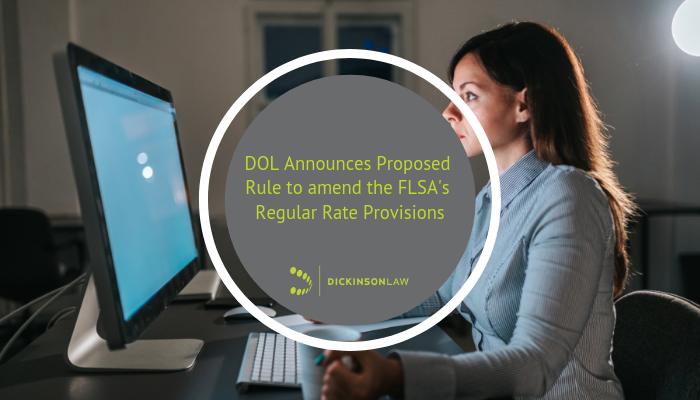DOL Announces Proposed Rule to amend the FLSA’s Regular Rate Provisions

Posted on 03/29/2019 at 10:20 AM by Mike Staebell
On March 28, the U.S. Department of Labor announced a Notice of Proposed Rulemaking (NPRM) to clarify and amend the agency rules regarding the regular rate provisions of the Fair Labor Standards Act that have not been comprehensively revised in more than 50 years. Yesterday’s announcement was expected, per previous posts on this blog (11/2/18 & 2/5/19). The DOL states that the proposal will:
- clarify and better define the regular rate for today’s workplace practices;
- promote compliance with the FLSA;
- provide appropriate and updated guidance in an area of evolving law and practice;
- encourage employers to provide additional and innovative benefits to workers without fear of costly litigation.
The “regular rate” is not a non-exempt employee’s stated hourly rate of pay. Rather, a non-exempt employee’s regular rate of pay includes all money paid to the employee minus eight exclusions listed in the FLSA. The regular rate is calculated each week by dividing the employee’s total weekly pay (not including the eight exclusions) by the number of hours worked by that employee in the workweek. The regular rate is then used to compute overtime premium pay, or “time and one-half.” Employers sometimes miss the fact that the regular rate of pay includes pay for things like commissions, incentives, and non-discretionary bonuses, and erroneously pay overtime at time and one-half of the stated rate of pay.
The DOL highlights the following proposed changes and clarifications to its regular rate regulations at 29 C.F.R. Part 778, that it says would allow employers to exclude the following forms of pay from the calculation of an employee’s regular rate:
- the cost of providing wellness programs, onsite specialist treatment, gym access and fitness classes, and employee discounts on retail goods and services;
- payments for unused paid leave, including paid sick leave (including paid sick leave mandated by state or local law);
- reimbursed expenses, even if not incurred solely for the employer’s benefit;
- reimbursed travel expenses that do not exceed the maximum travel reimbursement permitted under the Federal Travel Regulation System;
- discretionary bonuses, including examples to provide clarity;
- benefit plans, including accident, unemployment, and legal services;
- tuition programs, such as reimbursement programs or repayment of educational debt; and
- pay for time that would not otherwise qualify as hours worked, including bona fide meal periods.
The DOL is proposing additional changes in this rulemaking, too, including the following:
- Clarifying that employers do not need a formal contract or agreement with employees in order to exclude certain premium rates of pay for working more than 8 hours in a day, working weekends, working holidays, and the like;
- Eliminating restrictions in 29 C.F.R. §§ 778.21 and 778.22 that “call back” pay and similar pay must be “infrequent and sporadic” to be excluded from the regular rate, but clarifying that the call-backs cannot be so regular so as to be essentially prearranged;
- Revising the “basic rate” regulations in 29 C.F.R. §§ 548.3 and 548.305. Under these regulations, employers can use an authorized “basic rate” to calculate overtime pay and, currently, can exclude additional payments that would increase overtime compensation by more than 50¢ per week on average for overtime workweeks covered by the period of the payments. The revision would update this limit to 40% of the federal minimum wage, or $2.90. (In my experience, use of the “basic rate” is rare.)
The DOL states that the proposed rules will not require employers to take any affirmative measures to come into compliance and do not impose any new requirements on employers. Based on an early and quick read of the NPRM, it appears this is true, as the rules will be relaxed, rather than tightened. When and if the new rules become final and effective, however, employers may be able to take advantage of the revisions to reduce overtime pay or offer certain new perks without the fear of adding to overtime costs.
If warranted, we will post additional details after taking a closer look at the NPRM.
The NPRM was published in the Federal Register on March 29, 2019. Comments may be submitted at www.regulations.gov . The comment period closes on May 28, 2019.
For more information, check out the DOL’s Fact Sheet: “Notice of Proposed Rulemaking to Update the Regulations Governing the Regular Rate under the FLSA.”
Categories: Wage & Hour Watch, Employment & Labor Law
Questions, Contact us today.
The material, whether written or oral (including videos) that is posted on the various blogs of Dickinson Bradshaw is not intended, nor should it be construed or relied upon, as legal advice. The opinions expressed in the various blog posting are those of the individual author, they may not reflect the opinions of the firm. Your use of the Dickinson Bradshaw blog postings does NOT create an attorney-client relationship between you and Dickinson, Bradshaw, Fowler & Hagen, P.C. or any of its attorneys. If specific legal information is needed, please retain and consult with an attorney of your own selection.







